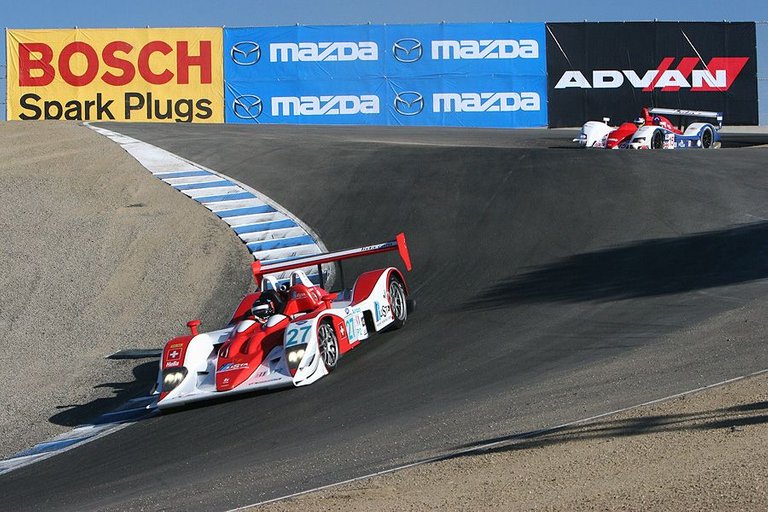
The Laguna Seca Raceway is one of North America's greatest ever race tracks. Located about a 5-hour drive from the city of Los Angeles in Monterey County, the area was transformed in 1916 for agricultural use which destroyed the surrounding historical wetland ecosystem. The track today is built around what was once a lake and the track name, Laguna Seca, translates to "dry lagoon" in Spanish.
In 1957 locals banded together, planned and constructed the $1.5m track in only 60 days. Today the race track is a significant part of Monterey County's population of over 439,000 as the track helps generate over $62m toward the local economy.
The course has undergone changes since it's construction to meet ever evolving safety requirements. Laguna Seca remained unchanged up until 1988 with the most significant change the addition of an infield area which eliminated a straight and lengthened the track to 1.9 mi (3.058 km). In 1996 the track was further altered to it's current format which is now 2.238 mi (3.602 km) long across 11 turns.

You won't believe the height this particular corner drops in height
Source: Photo by Clemson shared under Creative Commons (CC) license.
Despite the alterations Laguna Seca has one of the most iconic corners in race track history. The world famous "Corkscrew" greets racers at Turns 8 and 8A with a spectacular view of the sky. Drivers are then met with a sudden downhill hard left, hard right turn across two apexes which plummets racers an astonishing five-and-a-half stories in 450 feet (137 metres) of track in roller coaster-like fashion.
After surviving the Corkscrew racers are then met with Rainey Curve at Turn 9, the total elevation fall from the top of the Corkscrew totalling a whopping 109 feet (33 metres) which is equivalent to 10 stories! That makes the Corkscrew the best track corner in the world.
If you were serious about taking the Corkscrew plunge you could rent the track for about $20,000 a day. For the rest of us, Gran Turismo will be the closest we ever get to the real thing. As a 9-year old I remember racing a Dodge Viper in Gran Turismo 2 and more than 20 years later, I'm now doing the same thing in the eighth mainline instalment of the series.
Top Gear's Jeremy Clarkson has raced both the Gran Turismo version and the real thing. In 2005 Clarkson clocked a GT4 time of 1:41.148 around Laguna Seca in a Honda NSX.
Clarkson then attempted to beat his Gran Turismo time on the real track using a real NSX but could only manage a time of 1:57. Clarkson mentioned there were some minor details from the track that weren't included in the game but that's not the reason why his lap time was almost 16 seconds slower.
The main difference resulting in a great gap between Clarkson's game and real time is consequences. In the gaming version there's no fear of crashing as the only thing you're going to lose is nothing more than a bad lap time. In real life there's the fear of physical injury and real life damage to the car.
Motor Racing in general can be deadly and in 1999 Laguna Seca's Corkscrew proved just to be that. During an open wheel car race Uruguayan driver Gonzalo Rodríguez - who Autosport named on their list of 50 greatest drivers never to have raced in Formula One - died during a 1999 CART qualifying session. At the end of the Rahal Straight and on approach to the Corkscrew he hit the wall at about 140mph (225kph) and was killed instantly due to injuries sustained to his head.
The Corkscrew remains one of the most challenging corners in motor racing and some racers get through it by feeling the corner as opposed to eyeing out a landmark to make a move. Other racers use the more mainstream approach of a visual cue and more specifically using the trees at the end of Rahal Straight, aiming for the third one over as a point to take on the Corkscrew.
On September 8, 1996, one of the most famous overtakes in racing history took place on the Corkscrew. Known as "The Pass", Alex Zanardi overtook Bryan Herta on at the Corkscrew at the final race of the 1996 PPGA Indy Car World Series on the last lap.
With Herta seemingly on his way to a race win, Zanardi dive-bombed his way on the inside of the Corkscrew barely missing Herta and a concrete barrier. The move was so bold and daring, it goes down in folklore as one of the greatest passes in racing history. You've got to see it to believe it and the move sums up why the Corkscrew is one of the best corners in world racing.
THANK YOU FOR YOUR SUPPORT!
Wolfgang Sport started in 2017 as a way to connect my passion for American and British sports. Today it's evolved into a blockchain sports blog pushing the boundaries into the crypto world and embracing Web3 technologies.